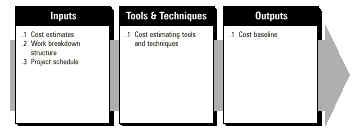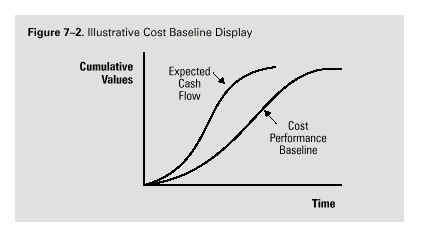7
Project
Cost
Management |
Project Cost Management includes
the processes required to ensure that the project is
completed within the approved budget. Figure 7–1 provides
an overview of the following major processes:
7.1 Resource Planning—determining
what resources (people, equipment, materials) and what
quantities of each should be used to perform project
activities.
7.2 Cost Estimating—developing an
approximation (estimate) of the costs of the resources
needed to complete project activities.
7.3 Cost Budgeting—allocating
the overall cost estimate to individual work items.
7.4 Cost Control—controlling
changes to the project budget.
These processes interact with each other and with the
processes in the other knowledge areas as well. Each
process may involve effort from one or more individuals
or groups of individuals based on the needs of the
project. Each process generally occurs at least once in
every project phase.
Although the processes are presented here as discrete
elements with well-defined interfaces, in practice they
may overlap and interact in ways not detailed here.
Process interactions are discussed in detail in Chapter
3. Project cost management is primarily concerned with
the cost of the resources needed to complete project
activities. However, project cost management should also
consider the effect of project decisions on the cost of
using the project product.
For example, limiting the number of design reviews may
reduce the cost of the project at the expense of an
increase in the customer’s operating costs. This
broader view of project cost management is often called life-cycle
costing. In many application areas predicting and
analyzing the prospective financial performance of the
project product is done outside the project. In others
(e.g., capital facilities projects), project cost
management also includes this work. When such predictions
and analysis are included, project cost management will
include additional processes and numerous general
management techniques such as return on investment,
discounted cash flow, payback analysis, and others.
Project cost management should consider the information
needs of the project stakeholders—different
stakeholders may measure project costs in different ways
and at different times. For example, the cost of a
procurement item may be measured when committed, ordered,
delivered, incurred, or recorded for accounting purposes.
When project costs are used as a component of a reward
and recognition system (reward and recognition systems
are discussed in Section 9.3.2.3), controllable and
uncontrollable costs should be estimated and budgeted
separately to ensure that rewards reflect actual
performance.
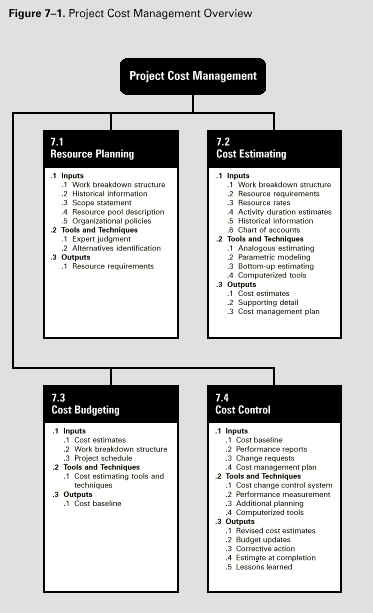
On some projects,
especially smaller ones, resource planning, cost
estimating, and cost budgeting are so tightly linked that
they are viewed as a single process (e.g., they may be
performed by a single individual over a relatively short
period of time). They are presented here as distinct
processes because the tools and techniques for each are
different.
|
7.1
Resource
Planning |
Resource planning
involves determining what physical resources (people,
equipment, materials) and what quantities of each should
be used to perform project activities. It must be closely
coordinated with cost estimating (described in Section
7.2). For example:
- A construction
project team will need to be familiar with local
building codes. Such knowledge is often readily
available at virtually no cost by using local
labor. However, if the local labor pool lacks
experience with unusual or specialized
construction techniques, the additional cost for
a consultant might be the most effective way to
secure knowledge of the local building codes.
- An automotive design
team should be familiar with the latest in
automated assembly techniques. The requisite
knowledge might be obtained by hiring a
consultant, by sending a designer to a seminar on
robotics, or by including someone from
manufacturing as a member of the team.
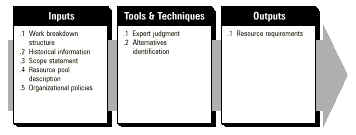
7.1.1 Inputs to
Resource Planning
.1 Work breakdown structure.
The work breakdown structure (WBS, described in
Section 5.3.3.1) identifies the project elements that
will need resources and thus is the primary input to
resource planning. Any relevant outputs from other
planning processes should be provided through the WBS to
ensure proper control.
.2 Historical information. Historical
information regarding what types of resources were
required for similar work on previous projects should be
used if available.
.3 Scope statement. The
scope statement (described in Section 5.2.3.1) contains
the project justification and the project objectives,
both of which should be considered explicitly during
resource planning.
.4 Resource pool description. Knowledge
of what resources (people, equipment, material) are
potentially available is necessary for resource planning.
The amount of detail and the level of specificity of the
resource pool description will vary. For example, during
the early phases of an engineering design project, the
pool may include "junior and senior engineers"
in large numbers. During later phases of the same
project, however, the pool may be limited to those
individuals who are knowledgeable about the project as a
result of having worked on the earlier phases.
.5 Organizational policies. The
policies of the performing organization regarding
staffing and the rental or purchase of supplies and
equipment must be considered during resource planning.
7.1.2
Tools and Techniques for Resource Planning
.1 Expert judgment. Expert
judgment will often be required to assess the inputs to
this process. Such expertise may be provided by any group
or individual with specialized knowledge or training and
is available from many sources including:
- Other
units within the performing organization.
- Consultants.
- Professional
and technical associations.
- Industry
groups.
.2
Alternatives identification. Alternatives
identification is discussed in Section 5.2.2.3.
7.1.3 Outputs from Resource Planning
.1 Resource requirements. The
output of the resource planning process is a description
of what types of resources are required and in what
quantities for each element of the work breakdown
structure. These resources will be obtained either
through staff acquisition (described in Section 9.2) or
procurement (described in Chapter 12).
|
7.2
Cost
Estimating |
Cost
estimating involves developing an approximation
(estimate) of the costs of the resources needed to
complete project activities. When a project is performed
under contract, care should be taken to distinguish cost
estimating from pricing. Cost estimating involves
developing an assessment of the likely quantitative
result—how much will it cost the performing
organization to provide the product or service involved.
Pricing is a business decision—how much will the
performing organization charge for the product or
service—that uses the cost estimate as but one
consideration of many.
Cost estimating includes identifying and considering
various costing alternatives. For example, in most
application areas, additional work during a design phase
is widely held to have the potential for reducing the
cost of the production phase. The cost estimating process
must consider whether the cost of the additional design
work will offset the expected savings.
Inputs
Tools & Techniques Outputs
7.2.1 Inputs to
Cost Estimating
.1 Work breakdown structure. The
WBS is described in Section 5.3.3.1. It will be used to
organize the cost estimates and to ensure that all
identified work has been estimated.
.2 Resource requirements. Resource
requirements are described in Section 7.1.3.1.
.3 Resource rates. The
individual or group preparing the estimates must know the
unit rates (e.g., staff cost per hour, bulk material cost
per cubic yard) for each resource in order to calculate
project costs. If actual rates are not known, the rates
themselves may have to be estimated.
.4 Activity duration estimates.
Activity duration estimates (described in Section
6.3) will affect cost estimates on any project where the
project budget includes an allowance for the cost of
financing (i.e., interest charges).
.5 Historical information. Information
on the cost of many categories of resources is often
available from one or more of the following sources:
- Project
files—one or more of the organizations
involved in the project may maintain records of
previous project results that are detailed enough
to aid in developing cost estimates. In some
application areas, individual team members may
maintain such records.
- Commercial cost
estimating databases—historical information
is often available commercially.
- Project team
knowledge—the individual members of the
project team may remember previous actuals or
estimates. While such recollections may be
useful, they are generally far less reliable than
documented results.
.6 Chart of accounts.
A chart of accounts describes the coding
structure used by the performing organization to report
financial information in its general ledger. Project cost
estimates must be assigned to the correct accounting
category.
7.2.2 Tools and Techniques for Cost Estimating
.1 Analogous estimating. Analogous
estimating, also called top-down estimating, means
using the actual cost of a previous, similar project as
the basis for estimating the cost of the current project.
It is frequently used to estimate total project costs
when there is a limited amount of detailed information
about the project (e.g., in the early phases). Analogous
estimating is a form of expert judgment (described in
Section 7.1.2.1).
Analogous estimating is generally less costly than other
techniques, but it is also generally less accurate. It is
most reliable when (a) the previous projects are similar
in fact and not just in appearance, and (b) the
individuals or groups preparing the estimates have the
needed expertise.
.2 Parametric modeling. Parametric
modeling involves using project characteristics
(parameters) in a mathematical model to predict project
costs. Models may be simple (residential home
construction will cost a certain amount per square foot
of living space) or complex (one model of software
development costs uses 13 separate adjustment factors
each of which has 5–7 points on it).
Both the cost and accuracy of parametric models varies
widely. They are most likely to be reliable when (a) the
historical information used to develop the model was
accurate, (b) the parameters used in the model are
readily quantifiable, and (c) the model is scalable
(i.e., it works as well for a very large project as for a
very small one).
.3 Bottom-up estimating. This
technique involves estimating the cost of individual work
items, then summarizing or rolling-up the individual
estimates to get a project total. The cost and accuracy
of bottom-up estimating is driven by the size of the
individual work items: smaller work items increase both
cost and accuracy. The project management team must weigh
the additional accuracy against the additional cost.
.4 Computerized tools. Computerized
tools such as project management software and
spreadsheets are widely used to assist with cost
estimating. Such products can simplify the use of the
tools described above and thereby facilitate rapid
consideration of many costing alternatives.
7.2.3 Outputs from Cost Estimating
.1 Cost estimates. Cost
estimates are quantitative assessments of the likely
costs of the resources required to complete project
activities. They may be presented in summary or in
detail. Costs must be estimated for all resources that
will be charged to the project. This includes, but is not
limited to, labor, materials, supplies, and special
categories such as an inflation allowance or cost
reserve.
Cost estimates are generally expressed in units of
currency (dollars, francs, yen, etc.) in order to
facilitate comparisons both within and across projects.
Other units such as staff hours or staff days may be
used, unless doing so will misstate project costs (e.g.,
by failing to differentiate among resources with very
different costs). In some cases, estimates will have to
be provided using multiple units of measure in order to
facilitate appropriate management control.
Cost estimates may benefit from being refined during the
course of the project to reflect the additional detail
available. In some application areas, there are
guidelines for when such refinements should be made and
what degree of accuracy is expected. For example, AACE
International has identified a progression of five types
of estimates of construction costs during engineering:
order of magnitude, conceptual, preliminary, definitive,
and control.
.2 Supporting detail. Supporting
detail for the cost estimates should include:
- A description of the
scope of work estimated. This is often provided
by a reference to the WBS.
- Documentation of the
basis for the estimate, i.e., how it was
developed.
- Documentation of any
assumptions made.
- An indication of the
range of possible results, for example, $10,000
± $1,000 to indicate that the item is expected
to cost between $9,000 and $11,000.
The amount and type of
additional detail varies by application area. Retaining
even rough notes may prove valuable by providing a better
understanding of how the estimate was developed.
.3 Cost management plan. The cost
management plan describes how cost variances will be
managed (e.g., different responses to major problems than
to minor ones). A cost management plan may be formal or
informal, highly detailed or broadly framed based on the
needs of the project stakeholders. It is a subsidiary
element of the overall project plan (discussed in Section
4.1.3.1).
|
7.4
Cost
Control |
Cost control is concerned with (a) influencing the
factors which create changes to the cost baseline to
ensure that changes are beneficial, (b) determining that
the cost baseline has changed, and (c) managing the
actual changes when and as they occur. Cost control
includes:
- Monitoring cost
performance to detect variances from plan.
- Ensuring that all
appropriate changes are recorded accurately in
the cost baseline.
- Preventing incorrect,
inappropriate, or unauthorized changes from being
included in the cost baseline.
- Informing appropriate
stakeholders of authorized changes.
Cost control includes searching out the "whys"
of both positive and negative variances. It must be
thoroughly integrated with the other control processes
(scope change control, schedule control, quality control,
and others as discussed in Section 4.3). For example,
inappropriate responses to cost variances can cause
quality or schedule problems or produce an unacceptable
level of risk later in the project.
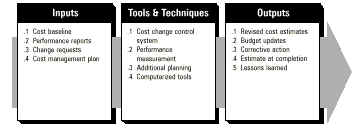
7.4.1 Inputs to
Cost Control
.1 Cost baseline. The cost
baseline is described in Section 7.3.3.1.
.2 Performance reports. Performance
reports (discussed in Section 10.3.3.1) provide
information on cost performance such as which budgets
have been met and which have not. Performance reports may
also alert the project team to issues which may cause
problems in the future.
.3 Change requests. Change
requests may occur in many forms—oral or written,
direct or indirect, externally or internally initiated,
and legally mandated or optional. Changes may require
increasing the budget or may allow decreasing it.
.4 Cost management plan. The
cost management plan is described in Section 7.2.3.3.
7.4.2 Tools and Techniques for Cost Control
.1 Cost change control system.
A cost change control system defines the
procedures by which the cost baseline may be changed. It
includes the paperwork, tracking systems, and approval
levels necessary for authorizing changes. The cost change
control system should be integrated with the overall
change control system discussed in Section 4.3.
.2 Performance measurement. Performance
measurement techniques, described in Section 10.3.2, help
to assess the magnitude of any variations which do occur.
Earned value analysis, described in Section 10.3.2.4, is
especially useful for cost control. An important part of
cost control is to determine what is causing the variance
and to decide if the variance requires corrective action.
.3 Additional planning. Few projects run exactly
according to plan. Prospective changes may require new or
revised cost estimates or analysis of alternative
approaches.
.4 Computerized tools. Computerized
tools such as project management software and
spreadsheets are often used to track planned costs vs.
actual costs, and to forecast the effects of cost
changes.
7.4.3 Outputs from Cost Control.
.1 Revised cost estimates. Revised
cost estimates are modifications to the cost information
used to manage the project. Appropriate stakeholders must
be notified as needed. Revised cost estimates may or may
not require adjustments to other aspects of the overall
project plan.
.2 Budget updates. Budget
updates are a special category of revised cost estimates.
Budget updates are changes to an approved cost baseline.
These numbers are generally revised only in response to
scope changes. In some cases, cost variances may be so
severe that "rebaselining" is needed in order
to provide a realistic measure of performance.
.3 Corrective action. Corrective
action is anything done to bring expected future project
performance into line with the project plan.
.4 Estimate at completion. An
estimate at completion (EAC) is a forecast of total
project costs based on project performance. The most
common forecasting techniques are some variation of:
- EAC = Actuals to date
plus the remaining project budget modified by a
performance factor, often the cost performance
index described in Section 10.3.2.4. This
approach is most often used when current
variances are seen as typical of future
variances.
- EAC = Actuals to date
plus a new estimate for all remaining work. This
approach is most often used when past performance
shows that the original estimating assumptions
were fundamentally flawed, or that they are no
longer relevant due to a change in conditions.
- EAC = Actuals to date
plus remaining budget. This approach is most
often used when current variances are seen as
atypical and the project management team’s
expectation is that similar variances will not
occur in the future. Each of the above approaches
may be the correct approach for any given work
item.
.5 Lessons learned. The
causes of variances, the reasoning behind the corrective
action chosen, and other types of lessons learned from
cost control should be documented so that they become
part of the historical database for both this project and
other projects of the performing organization.
|



